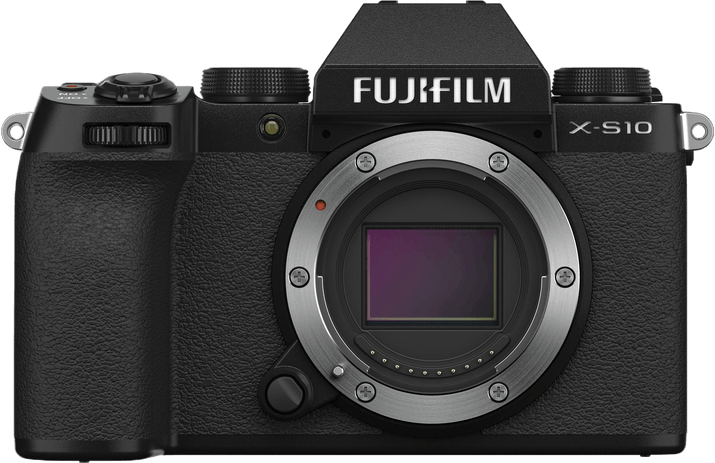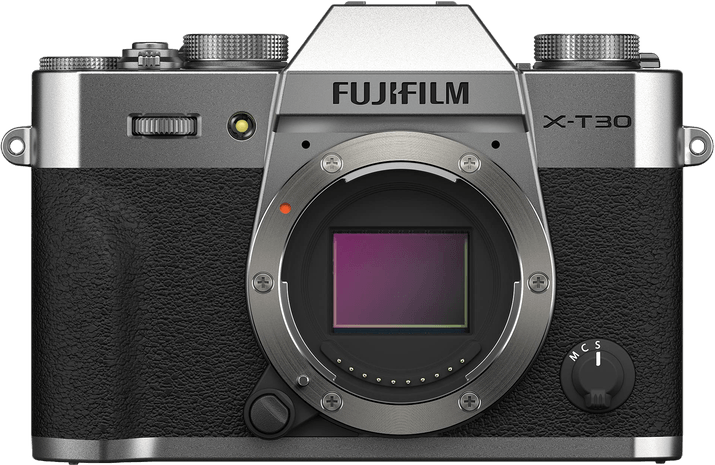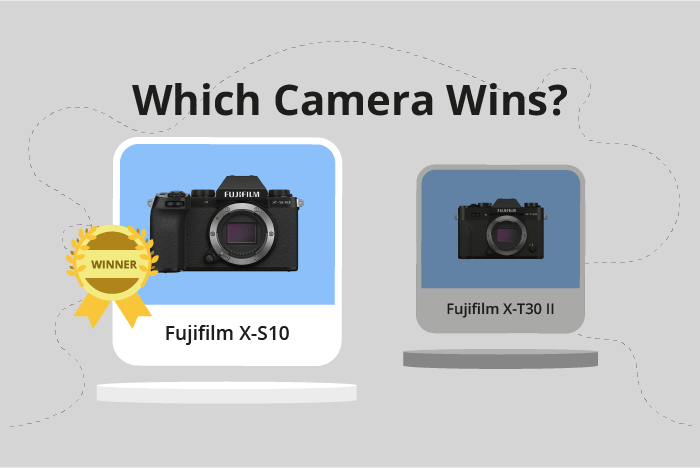Fujifilm X-S10 vs X-T30 II Comparison
Fujifilm X-S10

Fujifilm X-T30 II

The Fujifilm X-S10 takes the lead with a score of 69/100, compared to the Fujifilm X-T30 II‘s score of 65/100. Both cameras are mirrorless and were released within a year of each other, with the X-S10 in 2020 and the X-T30 II in 2021. They share similar launch prices, at $999 and $899, respectively.
The X-S10 stands out with its larger size, measuring 126 x 85 x 65mm and weighing 465g. This size and weight difference might make it more comfortable to hold and operate for some users. On the other hand, the X-T30 II is more compact at 118 x 83 x 47mm and lighter, weighing just 383g, making it an excellent choice for those who prioritize portability.
Given their respective scores and specifications, the Fujifilm X-S10 is a better camera for those who prefer a slightly larger and heavier build, while the Fujifilm X-T30 II is ideal for photographers seeking a more compact and lightweight option.
Fujifilm X-S10 vs X-T30 II Overview and Optics
The Fujifilm X-S10 outperforms the Fujifilm X-T30 II in optics, scoring 72/100 compared to the X-T30 II’s 67/100. Both cameras share several specifications, such as 26-megapixel sensors, CMOS sensor types, X-Processor 4 processors, APS-C sensor sizes, and Fujifilm X lens mounts. DXOMARK does not score Fujifilm cameras, so there are no DXOMARK sensor scores for these models.
The X-S10 excels in optics, primarily due to its image stabilization feature, which the X-T30 II lacks. Image stabilization is crucial for capturing sharp images in various conditions, particularly in low light or when using longer focal lengths. This advantage makes the X-S10 a more versatile choice for photographers who need reliable performance in diverse situations.
On the other hand, the X-T30 II has a faster shooting speed of 30 frames per second, compared to the X-S10’s 20 frames per second. This difference may benefit photographers capturing fast-moving subjects or action scenes, where a higher shooting speed can help ensure the perfect shot.
In assessing the optics of these two cameras, the Fujifilm X-S10’s image stabilization gives it a clear advantage over the X-T30 II, making it the better choice for photographers who prioritize versatility and image quality. However, the X-T30 II’s faster shooting speed may appeal to those who focus on action photography. Ultimately, the choice between these cameras will depend on the specific needs and priorities of the photographer.
Fujifilm X-S10 vs X-T30 II Video Performance
The Fujifilm X-S10 and the Fujifilm X-T30 II both have a video score of 91/100, making them equal in terms of overall video capabilities. They share common features such as a maximum video resolution of 4K, video dimensions of 4096 x 2160, and built-in time-lapse functionality.
However, the Fujifilm X-S10 outperforms the X-T30 II in one key area: the maximum video frame rate. The X-S10 can capture video at an impressive 240fps, while the X-T30 II is limited to 120fps. This significant difference allows the X-S10 to produce smoother slow-motion footage, providing videographers with more creative options when shooting.
On the other hand, the Fujifilm X-T30 II does not offer any notable advantages over the X-S10 in terms of video capabilities. Both cameras have the same video score and share most of their video features, making the X-T30 II a solid choice but not a standout in this comparison.
Taking these factors into account, the Fujifilm X-S10 proves to be the better camera for video enthusiasts due to its higher maximum frame rate. This advantage allows it to produce smoother slow-motion footage, giving videographers an edge in their creative pursuits. The Fujifilm X-T30 II, while still a capable camera, does not offer any significant advantages over the X-S10 in terms of video performance. As a result, those seeking superior video capabilities should opt for the Fujifilm X-S10.
Fujifilm X-S10 vs X-T30 II Features and Benefits
The Fujifilm X-S10 and the Fujifilm X-T30 II both have a feature score of 70/100, making them equal in this aspect. They share several specifications, including a 3-inch screen size, a screen resolution of 1040000 dots, touchscreen capability, flip screen functionality, and Bluetooth connectivity. Neither camera has GPS.
The Fujifilm X-S10 excels in certain areas compared to the X-T30 II. However, it does not have any unique features that make it superior to the X-T30 II, as they both share the same score and specifications mentioned above. The X-S10 may have a slight edge in terms of design, but this factor is subjective and depends on individual preferences.
On the other hand, the Fujifilm X-T30 II has one advantage over the X-S10, which is its built-in Wi-Fi connectivity. This feature allows users to transfer images and control the camera remotely using a smartphone or tablet. This convenience can be beneficial for photographers who need to share their images quickly or want to control their camera from a distance.
Based on the specifications provided, the Fujifilm X-S10 and the X-T30 II are evenly matched in terms of features, with the only notable difference being the Wi-Fi connectivity present in the X-T30 II. Users should consider their specific needs and preferences when choosing between these two cameras, as the overall experience and performance will be similar. The Fujifilm X-T30 II may be more suitable for those who prioritize wireless connectivity, while the X-S10 remains a solid choice for those who are not concerned with this feature.
Fujifilm X-S10 vs X-T30 II Storage and Battery
The Fujifilm X-S10 and X-T30 II both score 35/100 for storage and battery, indicating no significant advantage of one over the other. Both cameras have a single memory card slot, accepting SD, SDHC, and SDXC cards with UHS-I compatibility.
The X-T30 II has a slightly better battery life, offering 380 shots per charge compared to the X-S10’s 325 shots. This difference is due to the X-T30 II using the NP-W126S battery, while the X-S10 uses the NP-126S battery. Both cameras also support USB charging, providing users with a convenient charging option.
Despite the X-T30 II’s longer battery life, both cameras perform similarly in terms of storage and battery. The X-S10’s marginally shorter battery life may not be a significant drawback for most users, and the shared storage specifications ensure that both cameras are suitable for various photography needs.
Alternatives to the Fujifilm X-S10 and X-T30 II
Are you still undecided about which camera is right for you? Have a look at these popular comparisons that feature the Fujifilm X-S10 or the Fujifilm X-T30 II:

